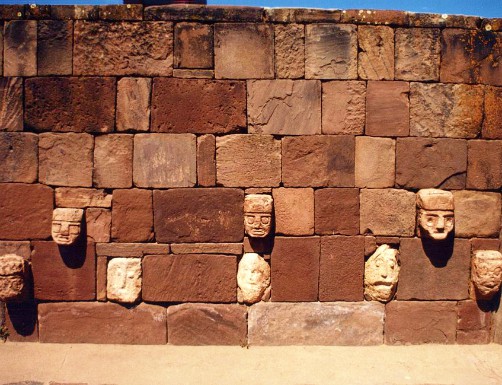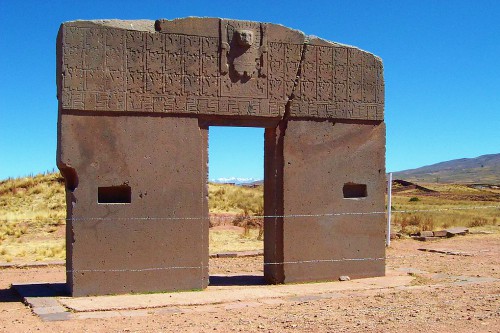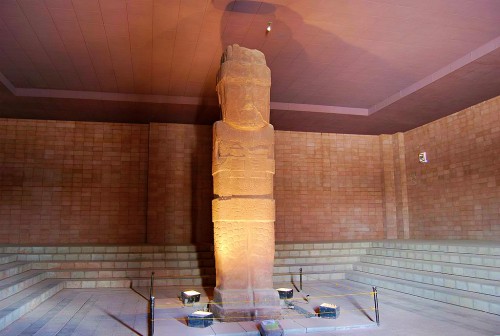|
Tiahuanaco (Tiwanaku) Tours Tiwanaku tours have become more and more popular since excavation has advanced and the museum has improved. Before 2009 the Aymara did not celebrate the equinox in June as they now do for tourists, nor did the other festivities that now attract tourists take place. Tiwanaku was just a tiny group of houses next to a mostly uncovered site. The only thing visible 20 years ago was the temple and the Gate of the Sun. As the Tiwanaku ruins are uncovered and facilities improve, more festivities and legends seem to appear as well. See more on our Tiwanaku Home Page.
It used to be a 3 hour drive to get to Tiahuanaco from La Paz. The museum was just a row of skulls in a room and there was nowhere to eat! Today the road is paved, it takes about an hour and a half to get there, and you can take a day tour easily from most tourist-oriented hotels and hostels for about $20-30. Tiwanaku tours are usually just day trips that leave from La Paz. Most leave at about 8 in the morning and return at about 4 pm. You can also choose a half-day Tiwanaku tour. You'll have lunch near the main square of town between visits to the Puerta del Sol, the Tiwanaku ruins and temples (with their amazing monolyths) and the on-site museum. If you would rather spend more time in the area, there are a few places to stay near Tiwanaku too. Click here to see Tiwanaku Hotels. Tour groups enjoy lunch and entrance into the ruins included in the price, along with a guide (some speak English, some don't speak it well at all). Tiwanaku Tours are the reason this little town has grown. Be sure to ask if the entry fee to the Tiwanaku ruins is included in the tour price. There are now several restaurants and souvenir shops as well. If you plan to travel to the Salar de Uyuni, you can include a stop at Tiwanaku on the way. Here's some information you should Know Before You Go and here's how to get there if you prefer to go to Tiwanaku on Your Own. What You'll See on Tiwanaku Tours1. The Stones - Las Piedras: One of the most interesting things about Tiwanaku is that the stones used to build the temples, some weighing up to 25 tons each, are not from the area. Some of the stones are made from basalt and the nearest place these stones are found is in Copacabana, about 38 Km from Tiwanaku. Other stones are sandstone and the nearest places these can be found are 5 Km away. All of the stones were transported to Tiwanaku before the wheel was invented. 2. The Akapana Pyramid - Pirámide Akapana: The pyramid is the largest structure and may have been used to store water in ancient times. Much of it no longer exists because its stones were used to construct other buildings on the Altiplano. In 2009 villagers and local authorities decided to renovate it with adobe putting it at risk of losing its status as a UN World Heritage Site. The pyramid is thought to have been a sepulcre and the remains of human sacrifices were found there. 3. The Kalasasaya Temple - Templo Kalasasaya: Even though they didn’t have the modern tools we now have, the stones of this temple were cut and put together so precisely that you cannot slide a knife between them. It housed what used to be a ceremonial platform, what may have been sleeping quarters for its priests, and several “monolitos” (monoliths) which are one of the more sought-after sights on Tiwanaku tours. It is known as the temple of the standing stones. 4. The Gate of the Sun - Puerta del Sol: This massive gate, called the Puerta del Sol, weighs over 13 tons and, although it has a crack in it, was built from a single rock. It stands upright and is one of the best known archeological symbols of Bolivia. It is one of the most extraordinary megalithic monuments made by an ancient civilization and was very accurately carved by Tiwanaku artists. According to interpretations of the symbols carved into it, the main symbol in the center represents the god Viracocha who created the Earth.
5. The Gate of the Moon - Puerta de la Luna - Lakakollu: This is another smaller and similar gate and has some interesting wildlife carvings on it. Lakakollu is the name of the mound upon which the gate of the moon stands. This monument is currently quite a distance from the other ruins. It is believed that this gate, also called "gate of the pantheon", may have originally stood next to the Gate of the Sun. 6. The Underground Temple - Templete Semisubterráneo: This partially subterranean temple has nearly 200 sculptures of heads. Some people say they look like aliens. They were most likely representative of ethnic cultures of the area. It's quite fascinating as no two are alike. 7. The Gate of the Puma - Puma Punku: Here, in Puma Punku, you can see enormous stone sculptures that weigh over 400 tons each. These megaliths were transported from an area near Lake Titicaca and were used to construct a system of blocks and platforms. Today these enormous rocks are tumbled and scattered over a small area. 8. Chunchukala: is a small structure located across from the Northwest corner of the temple of Kalasasaya that, despite having been unearthed, was largely ignored until recently. It is thought to have been a small ceremonial structure as access to it appears to have been limited and probably not a place the general population entered. 9. Palace of the Sarcophagi - Putuni: Here Arthur Posnansky found burial chambers very similar to sarcophagi, made from blocks of andesite. It is possible that this site was like a mausoleum for the burial of important Tiahuanacota personages. At this ruin, a headless monolith was discovered. The head was never found. 10. Kantatallita: A small sector of ruins where some fascinating rocks were found with very precise carvings and sculpturing, which indicate that the Tiahuanacotas built tools that enabled them to make very precise incisions in rocks. 11. Kerikala: his is a rectangular enclosure. The remains found around its central courtyard suggest that it may have served as living quarters for the Tiahuanacota priests. There isn't much else to see here at the moment, other than the structure itself.
12. The Monoliths - Los Monolitos: The monoliths are a group of sculptures that thought to represent important personages. The most important of these are the Monolito Bennett (named after the W.C. Bennett who discovered it) which now stands inside the on-site museum; and the Monolito Barbado or "bearded one", which is also known as "Kontiki" and has anthropomorphic features and zoomorphic decorations. They were found next to each other in the courtyard of the Underground Temple. The Monolito El Fraile (the Friar) is thought to have been one of the first sculptures to be built, because the level of detail does not compare with the rest of the monoliths found. It is located in Kalasasaya, close to the west balcony wall. The Monolito Ponce was named for Bolivian archaeologist Carlos Ponce Sanjinés, who is now deceased. It is located in the temple of Kalasasaya and is rich in Tiwanakota iconography and anthropomorphic symbols. Together they are guardians of this temple. 13. Festivities - Año Nuevo Aymara: If you happen to be in Bolivia near the end of June, the winter solstice festival is celebrated on June 21st at Tiwanaku marking the Machaj Mar (Aymara New Year). As Tiwanaku tours become more popular, more festivities have been planned to mark other equinoxes, solstices and special Aymara dates. 20 years ago none of these celebrations took place. It’s mostly done to attract tourism. Photo 1: https://commons.wikimedia.org/wiki/File:Tiwanaku3.jpg Learn more about TiwanakuTiwanaku tours sites and attractions How to get there and what to take Road maps and maps of the ruins Hotels, hostels and where to stay Tiwanaku photo and video gallery View our Tiwanaku travel forum How to get to Tiwanaku on your own Return to the Tiwanaku home page
    |


